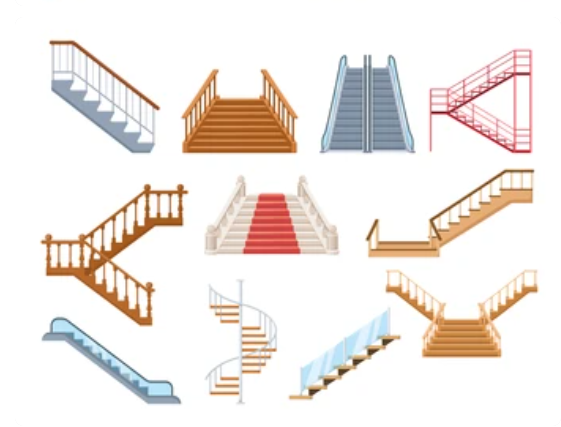A staircase in a building is provided to facilitate vertical movements. At present, there are many types of staircases being used in buildings and each of them has its own use and merits as well as demerits.
Types of stairs are described below-
- Straight Staircase: The straight stairs are ones which do not have any turn till the end and so does lead to one direction only. Many times it is not possible to provide straight stairs due to lack of space.
- Turning Staircase: The turning staircase is one in which there is at least one turn in their direction before landing. They are broadly used and have the following subtypes-
- Quarter turn Staircase: In case of quarter turn Staircase direction is changed once by right angle at once. If a quarter-turned staircase is branched into two flights at landing as shown below then it is called a bifurcated stair. These are the most common and wide applications in public buildings.
- Half-Turn Staircase: A stair turning through two right angles is known as a half-turn stair. A half-turn Staircase may be of dog-legged type or open newel type as shown below. In the case of dog-legged staircase, the flights run in opposite directions and there is no space between them in the plan.
- Three Quarter-Turn Staircase: When a staircase turns at the right-angle times till its landing it is called a tree Quarter-Turn staircase.
- Circular or Helical or Spiral Staircase: While the concern is of a circular Staircase, the steps radiate from the center and they do not have any landing or any intermediate newel post.
- Geometrical Staircase: These types of Staircases could possess any geometrical shape and they do not require any intermediate newel post.
Read Also- Types of Flooring in Building Construction
Requirements of a Good Staircase
- In order to make ascent and descent easy, the treads and riser should be properly designed.
Following thumb rules must be satisfied.- (Rise in cm) + (going in cm) = 40 to 45
- (Rise in cm) * (going in cm) = 410 to 450
- 2 times rise in cm + going in cm = 60 approximately
- Rise = 140 mm
Going = 300 mm Standard
- The inclination of a stair should be 30 to 40 degrees.
- Flight – It is not desirable to provide flight at more than 12 or a maximum at 15 steps.
Read Also-
Causes, Effects, and Remedies of Dampness in Buildings
Glass as a Building Material – A Birds Eye View
Purposes And Types Of Skirting In Building Construction
Stair Landings – Purposes and Standard Dimensions
Download Important Building Codes and Books-
Download National Building Code Part 1 & Part 2 PDF
Download the Building Construction Ebook by IGNOU (PDF)
